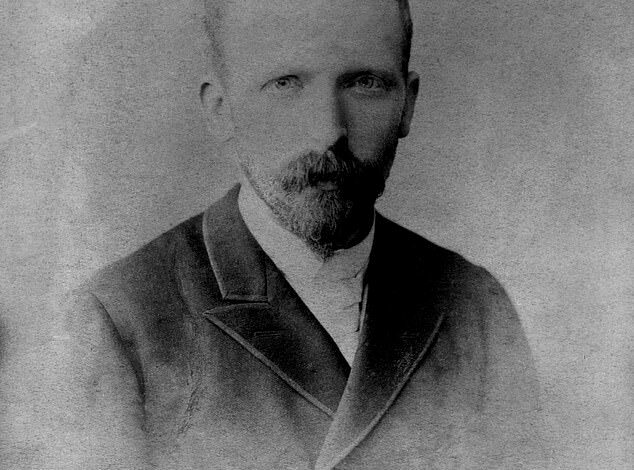Inside the night Vincent van Gogh sliced off his ear with a razor, took it to the front desk of a brothel – and police accused fellow artist Paul Gauguin of trying to murder him

The night before Christmas Eve 1888, Paul Gauguin slipped out of the house he was sharing with Vincent Van Gogh to take a walk around the quiet streets of Arles.
His mood was low. The light in the south of France might be conducive to painting, but his living conditions were unbearable. As the artist crossed the square, he heard quick, irregular footsteps.
Turning, he saw Van Gogh rushing towards him with an open razor in his hand. ‘My gaze at that moment must have been quite powerful, for he stopped and, lowering his head, set off running towards home,’ Gauguin recalled.
Later that night, Van Gogh used the same razor to chop off his own ear. For years afterwards, Gauguin would ask himself: might the outcome have been different if he had disarmed Van Gogh and tried to calm him down?
Two months earlier, barely scraping a living in Paris, Gauguin – who later became world famous for his paintings of Tahiti – had accepted an offer of 150 francs a month from Theo Van Gogh, Vincent’s brother, to move south to paint with Vincent.

A portrait of Vincent Van Gogh Gogh from his time at the French village of Auvers-sur-Oise when he produced many of his most famous works

French painter Henri Paul Gauguin pictured in 1885

‘Self-Portrait with Bandaged Ear’ 1889. by Vincent van Gogh

Gauguin later became world famous for his paintings of Tahiti. Pictured: Taperaa Mahana (Late Afternoon), 1892
Vincent’s psychotic episodes and mood swings had long been a problem for his family and were now proving to be exhausting for Gauguin.
Only the previous evening, Vincent, 35, had ordered an absinthe at a local cafe then, without warning, thrown the glass and its contents at him.
Gauguin, 40, had ducked the missile, taken Vincent firmly by the arm and conducted him home to bed.
Now, having been threatened with a razor, Gauguin did not dare go home and, instead, spent the night at a local hotel.
Returning to the house the next morning, Gauguin saw a great crowd gathered round the yellow-painted house and gendarmes trying to keep order.
Elbowing his way through, he heard that Vincent had gone back to the house and cut off his ear, close to the head.
At the door, a small man in a bowler hat grasped Gauguin’s arm. He was the chief of police and he asked Gauguin: ‘What have you done to your friend?’

The Starry Night, 1889, by Vincent van Gogh. It depicts the view from the east-facing window of his asylum room at Saint-Rémy-de-Provence, just before sunrise

Paul Gauguin, French post-impressionist painter, 1888

Self-portrait at the easel, 1888. Found in the Collection of Van Gogh Museum, Amsterdam
‘I don’t know.’
‘Oh yes… you know very well… he is dead.’
The police chief was accusing Gauguin of his murder.
This dramatic incident – one of many in Gauguin’s tumultuous life – has been illuminated anew by a recently discovered manuscript, part memoir, part last testament, which was missing for more than a century.
Avant et Apres, written in the two years before Gauguin’s death in 1903, gives us a new perspective on the painter’s life, relationships, thoughts, fears and beliefs.
His life was extraordinary even before he met Van Gogh – or set foot on Tahiti. The son of a political radical, he was bundled aboard a ship shortly after his first birthday to live with his mother’s relatives in Peru.
He later returned to France, became a successful investment banker and art collector and married Mette, a Danish woman with whom he had five children. The marriage floundered when he abandoned their conventional, middle-class life to paint, rendering himself a pauper.
Theo Van Gogh, a successful Paris art dealer, was the first person to pay real money – 400 francs – for one of Gauguin’s paintings (a huge relief at the time as it enabled him to give money to Mette).

Vincent Van Gogh, aged 19

Saint-Pol-de-Mausole’s asylum where Vincent van Gogh was interned

Bedroom in Arles, by Vincent van Gogh, 1888
Theo became his agent and, through him, Gauguin became friends with Vincent, who bombarded him with invitations to join him in Arles, dreaming of forming the Studio of the South, a group ‘something along the lines of the… English Pre-Raphaelites’.
Theo offered him 150 francs a month in exchange for paintings as encouragement.
Vincent’s ups often took the form of religious mania. His downs, depression and masochistic religious guilt.
He had wanted to become a clergyman, like his father, but a spell as an itinerant evangelist bringing the Gospel to coal miners in Belgium came to an end because he scared children, who threw things at him. The adults thought him a ‘lunatic’.
For a time, he had held down a job at the international art-dealing firm, Goupil et Cie, where his uncle, a partner, placed both Theo and Vincent until the latter’s mental problems became too great.
By 1888, he had been lodging with Theo in Paris for two years, turning his life and his apartment upside down.

French painter Paul Gauguin (1848 – 1903) seated in front of one of his paintings

Parau Api. What’s new?, 1892, by Gauguin

‘Where Do We Come From / What Are We / Where Are We Going’, by Paul Gauguin, 1897

Arearea no Varua ino (Words of the Devil or Reclining Tahitian Women), by Paul Gauguin

Ia Orana Maria (Hail Mary), 1891, by Paul Gauguin

Paul Gauguin (1848-1903) photographed In 1888
It came as a relief when Vincent decided to move to Arles. For Theo, the cost of renting a house for him and paying a monthly allowance to both Vincent and Gauguin came cheap at the price.
In late October, when Gauguin arrived, he found Vincent living in half a tiny house on the Place Lamartine, a seedy part of town housing brothels, the railway station and the Roman amphitheatre, where Sunday bullfights filled the air with bloodlust, sex-lust, sweat and wine.
Vincent had painted his half of the house’s exterior bright butter yellow, with shutters and door a vivid emerald green.
The street door led straight into Vincent’s studio. Gauguin thought it looked as if a volcano had erupted inside, spouting pictures and paint tubes all over the place.
Pictures stacked, rolled, pinned up and poked into corners had left coloured smudges on the walls.
To his horror, the silvery tubes scattered about were uncapped, the colours drying out. Paints were expensive and Gauguin always screwed the tops carefully back onto his own. The total effect was chaotic, blindingly colourful and difficult to take in.
When Gauguin had written to say he would be coming, Vincent had spent one frenzied week in August painting the Sunflowers series for which he is so famous. Fourteen Sunflowers, Fifteen Sunflowers, all for Gauguin, hung in his room like a huge welcoming bouquet, as Vincent wrote to Theo.

Cafe Terrace at Night, 1888, by Vincent van Gogh

Wheatfield and Cypress Trees, 1889, by Vincent van Gogh

When Gauguin had written to say he would be coming, Vincent had spent one frenzied week in August painting the Sunflowers series for which he is so famous
To reach Gauguin’s bedroom, they had first to go through Vincent’s. Their two tiny bedrooms occupied the entire upper floor.
No bathroom, no running water. Washing facilities were available in the bathhouses close to them which were also used by the inhabitants of the brothels.
What with the smell of irregularly emptied chamber pots and Vincent’s total indifference to the need to wash, to clear up tobacco ash or to cap his paints, the Yellow House stank. Gauguin insisted they find a cleaner.
Gauguin found Vincent difficult from the start. He ‘had an extraordinary way of pouring out sentences, if he got started, in Dutch, English and French, then glancing back at you over his shoulder, and hissing through his teeth.
‘In fact, when thus excited, he looked more than a little mad; at other times he was apt to be morose, as if suspicious.’
The first day was devoted to getting settled and to a great deal of talking and walking about, so Gauguin might admire the beauties of Arles, including Vincent’s favourite brothel.

Corridor in the Asylum, September 1889, by Vincent van Gogh

The Yellow House (The Street), 1888, by Vincent van Gogh
The following day, they went out painting in the countryside. Normally, this was the cue for local boys to shout and throw cabbage stalks at Vincent, who frightened them, but Gauguin’s burly figure by his side discouraged them.
Seeing their finances taking on the same chaos as his friend’s colour box, Gauguin installed a cash box. On top of it lay a scrap of paper and a pencil for them to write down what they took from it. He did the cooking. ‘Gauguin knows how to cook perfectly,’ Vincent wrote to Theo, awestruck.
One day Vincent volunteered to make the soup: ‘I do not know how he mixed up things – surely as he mixed his colours in his pictures – at any rate, we couldn’t eat it.
And my Vincent burst out laughing,’ Gauguin recalled. If Vincent was in an exalted mood, he would not stop talking, day or night.
When he was living with his brother, he would follow Theo into his bedroom at night, talking at him while he undressed, went to bed and blew out the candle, whereupon Vincent would draw up a chair close to his pillow and keep talking while Theo first pretended to go to sleep, then, with luck, actually did drop off.

Portrait of Mette and Paul Gauguin, 1885
As the weeks passed, Vincent’s work became more vivid, more hectic, more agitated: ‘He was furiously mad. I had to suffer for a month all the fears of a mortal tragic incident.’
He was also drinking too much, aware that ‘the electricity’ in his brain was building towards crisis.
November brought rain. No more painting en plein air. Imprisoned in the tiny house, Vincent became more agitated still.
Gauguin had enjoyed painting chairs, rousing curiosity through objects placed on their seats: a bouquet of flowers or a mysteriously stringless mandolin. Might this make a good indoor subject for the agitated Vincent?
The results were two of Van Gogh’s most famous paintings, Van Gogh’s Chair and Gauguin’s Chair.
Van Gogh’s is straw-bottomed, uncomfortably upright, with a pipe and tobacco on the seat. Gauguin’s is a much grander affair, of walnut wood like his bed, with curved arms and a broad seat with two modern novels and a candlestick to read them by.

Van Gogh’s chair is straw-bottomed, uncomfortably upright, with a pipe and tobacco on the seat

Gauguin’s is a much grander affair, of walnut wood like his bed, with curved arms and a broad seat with two modern novels and a candlestick to read them by.
What appallingly claustrophobic evenings those two chairs conjure, Vincent poker-backed on his chair, stupefied with drink, puffing on his smelly pipe, not reading, eyes boring intensely into Gauguin pretending to read his book, hoping to avoid a tirade.
Gauguin painted Vincent’s portrait, showing him in a state of mental disequilibrium: in The Painter of Sunflowers (1888), Vincent’s face is deconstructed, as blurred as his mind.
At first Vincent could not see the likeness but later, when his mental crisis had peaked and he was confined to the madhouse, he recognised it as accurate. ‘It was indeed me, extremely tired and charged with electricity as I was then.’
It was in this very agitated state that Vincent cut off his ear.
When he had staunched the blood, he had pulled on a Basque beret and gone to the nearby brothel, where, according to Gauguin, he gave the person on duty his ear in an envelope, saying: ‘Here is a souvenir of me.’
Another long-standing version of the story has Vincent delivering it direct to his favourite prostitute Rachel, with the words, ‘You might find this useful’, upon which she fainted.

Gauguin painted Vincent’s portrait, showing him in a state of mental disequilibrium: in The Painter of Sunflowers (1888), Vincent’s face is deconstructed, as blurred as his mind
Then he ran back home and up the stairs to his bedroom where he shut the shutters, lit an oil lamp, placed it on the table – and went to sleep.
The next day, having been accused of killing his friend, Gauguin entered the house with the chief of police. The little downstairs room was strewn with wet towels, stained red. The floor tiles and walls were splashed with blood.
They ascended the bloody stairs. Vincent lay on his bed, ‘humped up like a gun dog’. Gently, Gauguin touched the body, whose heat announced he was very much alive.
Gauguin asked the police chief to wake Vincent and, if he asked for Gauguin, to say he had left for Paris.
Then he went to telegraph Theo, who arrived by train the next morning, Christmas Day.
Gauguin was waiting for Theo at the hospital, where nobody was certain if Vincent would live. The first things he asked for, when he regained his speech, were his pipe and his friend Gauguin.
Gauguin lied that he had left for Paris because he did not want to upset Vincent further, but also because he did not know whether he could maintain his self-control.

Self portrait found in the collection of Van Gogh Museum

Theo van Gogh, a dutch art dealer and younger brother of Vincent van Gogh
He could not trust himself because he did not lightly, or immediately, get over being accused of murder. If Vincent had bled to death, there would have been no witness for Gauguin’s defence. He could have faced a trial for murder, followed by the guillotine, if found guilty.
Why the ear? Theories proliferate. Vincent said that his attacks of agitation were accompanied by voices in his head. Maybe he wanted to cut off the voices? Or maybe it had to do with the nearby bullfights.
At the end, with the bull dead, its ear was sometimes severed and awarded to the matador as a prize.
The cocky matador might then toss the bloody ear to a pretty girl in the crowd as an unmistakeable gesture of intent.
Vincent himself never gave a reason: ‘In my mental or nervous fever or madness, I don’t quite know what to say or how to name it, my thoughts sailed over many seas.’
Twelve days after the ear-cutting, Van Gogh wrote to Gauguin: ‘My dear friend Gauguin, I’m taking advantage of my first trip out of hospital to write you a few most sincere and profound words of friendship.
‘I have thought of you a great deal in the hospital, even in the midst of fever and relative weakness… I wish you prosperity in Paris.’
Gauguin continued to love and respect Vincent, to write to him and about him with affection, but he could not bear to see him ever again.
He turned down all Vincent’s eager suggestions that they resume the artistic struggle together but was careful to preserve Vincent’s fragile feelings and self-respect.
In July 1890, Vincent walked into a field carrying a gun. Ostensibly out to shoot rooks, instead he pointed it at his own stomach, and shot himself. He died two days later in Theo’s arms.
Many years later, when Gauguin was living in Polynesia, he sent to France for sunflower seeds. He planted them in his garden, tended them carefully and brought them to flower.
Then he painted them stuffed into a vase and sitting on a chair, in memory of his friend.
- Adapted from Wild Thing by Sue Prideaux (Faber & Faber, £30), out September 12. © Sue Prideaux 2024. To order a copy for £25.50 (offer valid to 05/10/24; UK P&P free on orders over £25) go to mailshop.co.uk/books or call 020 3176 2937.




